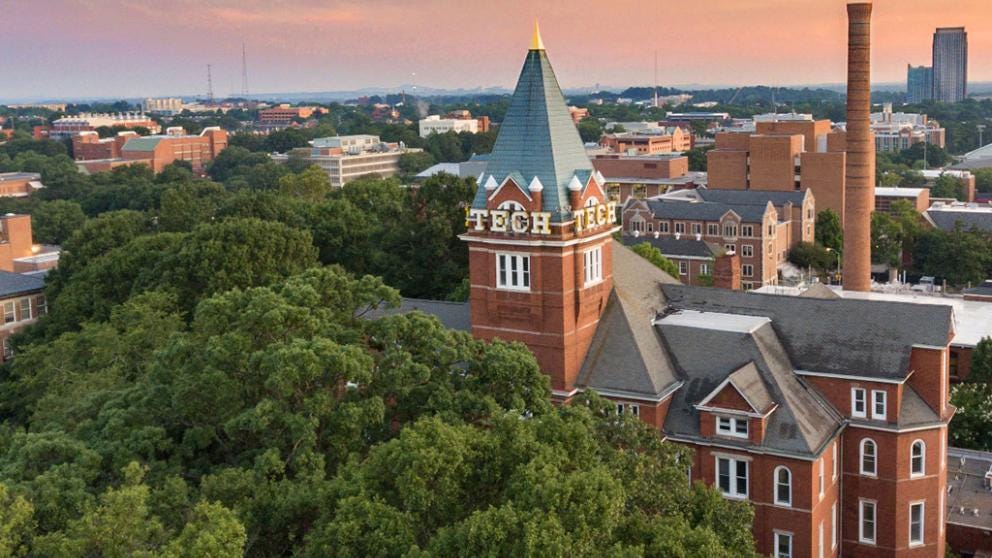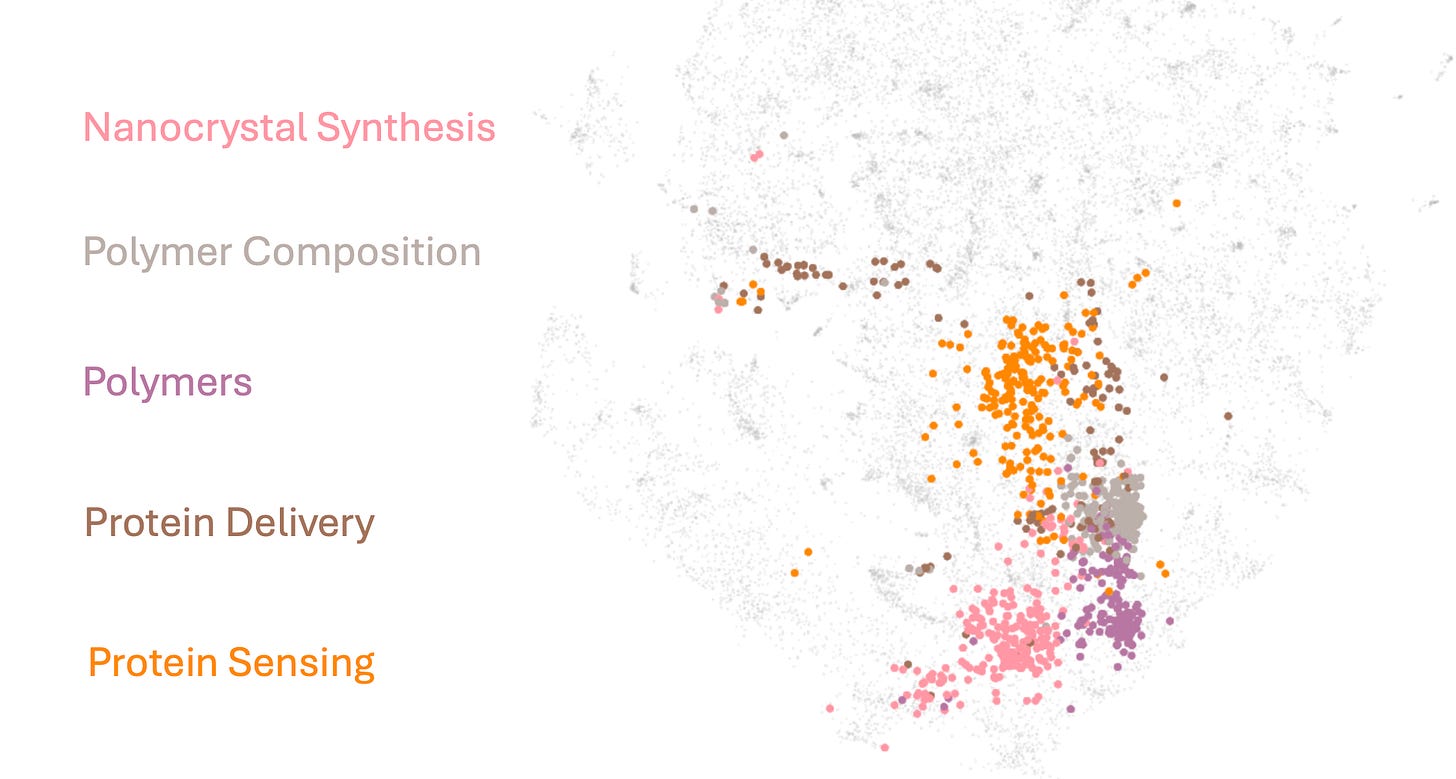Finding biotech breakthroughs in Atlanta
A Georgia Tech Case Study
This post is the fourth in a series on Stargaze™, Portal Innovations’ AI toolkit for sourcing, mapping, and predicting innovation. You can read the first three posts here:
When you think of Atlanta, what comes to mind? For me, it’s tree-covered hills, amazing food and music, deep multi-cultural history, and biotech.
Biotech? Yes, biotech.
It doesn’t take much digging to find Atlanta’s rich biotech roots. The CDC is headquartered there. The first ARVs - the drugs that transformed HIV treatment - were invented there. Some of the most successful drug developers in the world call Atlanta home. One of Portal’s first investments, Cardiosense, was founded by Omer Inan, whose lab at Georgia Tech is at the forefront of biomechanics and biosensing. But like in many other science-heavy cities around the world, many of the scientific breakthroughs born in Atlanta move away as children, to grow up somewhere else.
In 2021, our team at Portal Innovations made a bet that with the right infrastructure and the right people, that trend could be turned around. We believe that Atlanta is among a select group of US cities and neighborhoods that are overscienced but underfunded. These budding ecosystems are rich in scientific innovation, but lacking the physical and capital infrastructure to translate these innovations from the “Aha Moment” in the lab, through multiple rounds of venture investment, to an FDA-approved device or drug.
As we prepare to open our Science Square labs in 2024, we pointed Stargaze™ at Atlanta, to show quantitatively what we know intuitively to be true: Atlanta has the scientific foundation to become a serious biotech player. To start, we focused our Stargaze™ lens on Georgia Tech. What follows is a peak into the university’s rich biotech landscape, focusing on one of eight innovation clusters we identified and some of the innovators driving it forward.
Mapping the Biotech Landscape at Georgia Tech
Step 1: Visualize and Quantify the Landscape
We began by using Stargaze™ to (1) find all the papers, grants, patents, and startups associated with current Georgia Tech researchers and (2) tie them together into a biotech hypergraph. After extracting their “coordinates” we plotted them onto a Starchart™ - a visual representation of biotech innovation at GT. Eight innovation clusters immediately came into focus, illustrating Georgia Tech’s unique biotech Innovation Fingerprint. A quick visual examination of our Georgia Tech Starchart revealed a number of patterns, including several patent-heavy innovation clusters.
Like an astronomer searching the sky for intelligent life, or a physician seeking a complete picture of a patient’s health, our next step was to supplement our visual exam with more quantitative metrics. To do this, we combined several metrics commonly used by metascientists with our proprietary innovation biomarkers (not shown) to form a Biomarker Dashboard. Together, these informed us as we decided where to drill down further.
Step 2: Identify a Target Cluster
Again, several quick insights jumped out. Georgia Tech’s Materials Science cluster, for example, generates a particularly high number of patents per NIH dollar (Patent Yield Rate), as well as papers per NIH dollar (Paper Yield Rate). Whereas the Soil Microbiology cluster generates a high quantity of papers per NIH dollar, but fewer patents. Also, their Protein Structure cluster clearly stands out in its ability to attract Prestige Grants - the subset of grants awarded by the NIH to the most promising science and scientists.
Step 3: Zoom In
With all this in mind, we decided to drill down on the Materials Science cluster first. Using the same process we used to identify eight broad clusters of biotech innovation within Georgia Tech, we further divided Materials Science into forty-seven subclusters. As before, we investigated these first visually, using our Georgia Tech Starchart, and then quantitatively, using another Stargaze Scorecard.

After reviewing the Scorecard as a whole, we identified ten subclusters of interest:
Polymers, and Polymer Composition - the latter accounting for the lions share of patents within Materials Science.
Protein Delivery, and Protein Sensing - two topics of increasing importance at Georgia Tech. The former involves novel chemistries for delivering drugs. The latter focuses on developing biosensors for drug design and diagnostics.
Nanocrystals, and Nanotechnology - Traditionally focused on industrial applications, but increasingly converging with biotech.
Adsorption, Solar Cells, Semiconductors, and Surfactants/Wetability - all disciplines related to surface chemistry - reflect Georgia Tech’s leadership in clean energy and renewables technologies.
After removing this last group from our set, we were left with 5 subclusters, from 250+ initially.
Step 4: Identify Super Stars
Our last step was to zoom in on the individual stars within these 5 subclusters. What are they focused on? Which have the highest potential for generating a biotech breakthrough? We filtered the 215 Georgia Tech inventors working in these subclusters through our library of Superstar Biomarkers, to identify 9 high-potential innovators, across three career stages:
Two of these stars (Finn and Prausnitz) are already successful biotech founders in their own rights. Some (Yushin, El-Sayed, Fahrni) work in fields that are tangential to, and increasingly converging with, traditional biotechnologies. And others (Kwong, Peralta-Yahya, Coskun, Styczynski ) are just entering into their “translational phase.”
Dr. Pamela Peralta-Yahya’s research draws interest and funding from NASA, NIH, DARPA, and DOE. The lab sits at the intersection of biomedicine and chemical engineering. Her projects span from using protein engineering to design G-protein-coupled receptors to develop medically relevant biological circuits, to creating advanced biofuels to power a rocket returning from Mars.
Dr. Gabe Kwong focuses on synthetic immunity: engineered systems for treating and tracking disease progression. One of his key projects is using nanomaterials, scalable manufacturing, and drug delivery to improve engineered T-cell efficacy for treating cancers. Another focus, which earned his group significant ARPA-H (Advanced Research Projects Agency for Health) funding, is creating highly sensitive biosensors for the early detection of multiple cancers.
Dr. Ahmet Coskun’s research is around creating a “Google Maps of chemical activity at single cell level”. The lab focuses on single-cell spatial metabolomics with a new integrative technique for profiling human tissue to capture the geography, structure, movement, and function of molecules in a 3D picture. His goal is to arm physicians with a 3D micromap of the immune system and disease progression, allowing for enormous improvements in precision therapeutics for patients.
Dr. Mark Styczynski designs advanced mathematical and computational models of metabolic processes. By combining machine learning with metabolomic datasets, his group is able to improve the predictive accuracy of bacterial strains designed in silico, as well as develop novel biosensors and diagnostics. Ultimately, the goal of his lab is to exert control over biological systems - whether that is preventing cancer cells from growing and metastasizing or by metabolic engineering of yeast to increase feedstocks.
These innovators represent just one slice of the biotech landscape within Georgia Tech, which itself is but one of several heavyweight institutions in Georgia. The biotech future is looking bright in the Southeast, and we are looking forward to being part of it.
Interested in exploring the data yourself? Sign up to become a Stargaze Astronomer.
Join us for a virtual event, “Stargazing with Portal” on April 5th. We’ll be using Stargaze to zoom in on these and other trends we’ve spotted in the Georgia Tech biotech ecosystem.










Would love to see some of the productivity per NSF, DoD, and DoE dollar (NIH is covered). Much of the materials work coming out of GT, and specifically GT School of Materials Science and Engineering, is funded by these other three entities on top of many private industry funded projects - the latter of which may not show up in the form of published articles or other information found in databases.
Don’t forget about the innovations coming out of Emory!